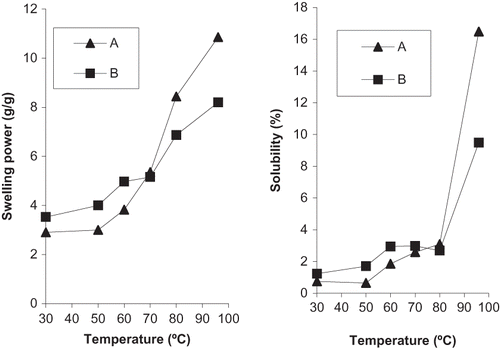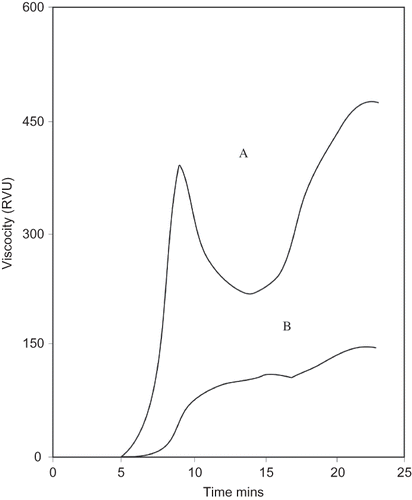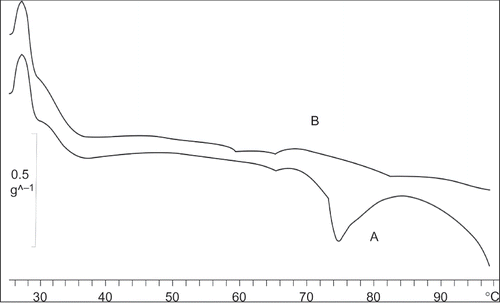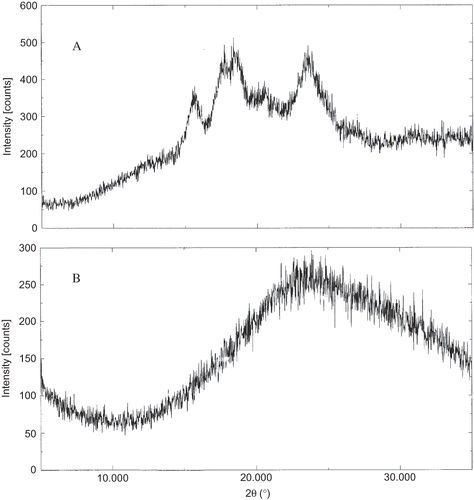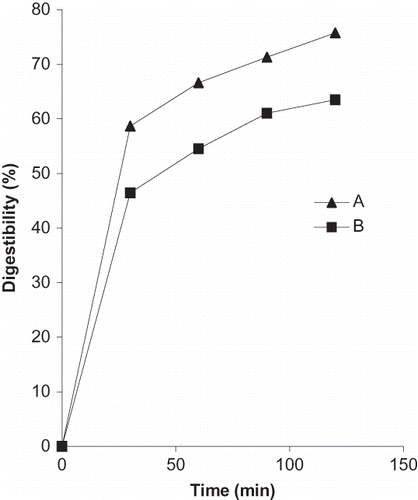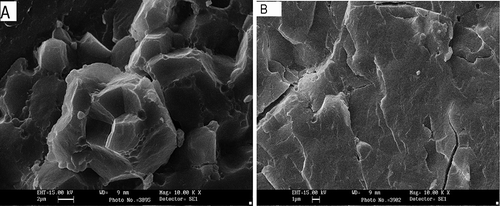Abstract
Functional properties of rice with slow carbohydrate digestibility developed by CFTRI (Mysore, India) were studied. The processed rice exhibited typical characteristics of pre-gelatinized starch, having high hydration at lower temperature (≤50°C) and low hydration capacity at higher temperatures (≥50°C). The insoluble amylose content and sediment volume of processed rice increased by 18.9 and 37.3%, respectively, compared to its native counterpart. Gel consistency was higher by four times, whereas resistant starch content of processed rice was higher by 2.6 times compared to native rice. The in-vitro carbohydrate digestibility of processed rice after 30 min was lower by 16% than its native counterpart. The pasting characteristics indices determined in rapid visco-analyser and the endothermic energy determined in the differential scanning calorimetry were considerably lower as compared to the native rice. The scanning electron microscopic examination revealed the continuous rigid matrix whereas the X-ray diffractograms showed negligible crystallinity of starch, indicating the presence of gelatinized starch in the processed rice. This observation indicates its suitability as a staple to the population at the risk of diabetes and obesity.
INTRODUCTION
Rice is a staple food in many parts of the world meeting most of the energy and protein needs of more than half of the global population. Rice, in general, and its carbohydrate, in particular, is known for rapid digestion and its regular intake affects the postprandial glucose homeostasis leading to hyperglycemic and this could be the probable reason for dissuading rice consumption not only by diabetics but also by the population at risk. However, the rice containing slow digestible carbohydrates could be useful for control and nutritional management of diabetics and hyperlipidemia.[Citation1] The glycemic index (GI) and the resistant starch (RS) content in cereal-based foods have been established as two important predictors of their carbohydrate digestibility. A variety of factors, both intrinsic and extrinsic, have been reported to influence the rate and extent of carbohydrate digestibility in rice and other foods.[Citation2] Determination of in-vivo carbohydrate digestibility or GI on human subjects is rather difficult and expensive, whereas, in-vitro measurement of available carbohydrates largely reflect GI of the foods, is inexpensive and easily adaptable.[Citation3] The rate of carbohydrate digestion determined by in-vitro method correlates significantly with GI of meals, as evidenced in glycemic response studies in young men.[Citation4]
Another important factor that influences the GI values of the foods is its RS content, since the RS fraction of starch escapes digestion in the small intestine; hence, it does not contribute for the glucose load of the food. RS in the food also increases fecal bulk and ferments in the colon and thereby lowers the colon pH and produces a range of short chain fatty acid (SCFA), primarily acetate, propionate, and butyrate, which exert beneficial effect with respect to decrease in the levels of glucose, cholesterol, and triglycerides.[Citation5] SCFA production has positive impact on bowel health. Hence, processing of rice to enhance its RS content is highly desirable.
Parboiling is one of the important rice processing technologies and it offers many advantages, such as improved milling, storage qualities, nutrient availability, and organoleptic properties besides enhancing the RS content. Parboiling is essentially pre-cooking the rice in the paddy form followed by drying and milling and generally believed to lower the glycemic response of rice.Citation6–8] Larsen et al.[Citation9] reported about 30% reduction of GI to raw rice in in-vivo experiments and also increased in RS content from 0.8 to 1.6% upon pressure parboiling. This shows that by adapting suitable processing conditions of parboiling of rice it may be possible to increase the RS content. The main reason for lowering the GI of parboiled rice is largely due to retrogradation, or re-association, of gelatinized starch during parboiling of paddy. Hence, the aim of present study was to investigate the effect of hydrothermal processing on the physico-chemical and functional properties of rice, its RS content, and in-vitro carbohydrate digestibility.
MATERIAL AND METHODS
Paddy or rough rice (BT variety) was procured from a local market, cleaned, and hydrothermally processed using the CFTRI patented process, to prepare the rice with slow carbohydrate digestibility.[Citation10] The process mainly involves soaking the paddy for about 16 h, steaming for 30 min, and exposing the same for temperature gradients that facilitates rapid retrogradation of starch. The processed paddy was milled to about 6% degree of polish and pulverized to pass through 60-mesh sieve. The proximate composition of native and processed rice, as obtained by analysis,[Citation11] is shown in . The flour was defatted using petroleum ether and was used for analysis.
Table 1 Proximate composition (%) of native and processed rice
Total Amylose Content
Defatted rice flour (100 mg, dry weight basis, db) taken in a 100-ml conical flask was wetted with distilled alcohol (1 ml), to which 10 ml, 1 N NaOH was added gently, stoppered, and left overnight. Subsequently, it was boiled vigorously using boiling water bath (97°C) for 10 min with gently mixing intermittently, cooled to room temperature, and the volume was made up to 100 ml with water. To an aliquot (5 ml) of the sample, about 50 ml water, 1 ml acetic acid (1N) and 2 ml of iodine solution (0.2%) were added, and the volume was made up to 100 ml. The blue colour developed was read at 630 nm against iodine blank.[Citation12]
Soluble Amylose Content
The defatted rice flour (100 mg, db) was wetted with distilled alcohol (1 ml) in conical flask, and about 50 ml distilled water was added to the flask and heated in a vigorously boiling water bath (97°C) for 20 min with occasional stirring. After cooling to the ambient temperature, the contents were made up to 100 ml and filtered through Whatman No. 4 filter paper, rejecting the first 15–20 ml portion, an aliquot (5 ml) of filtrate was diluted with about 50 ml water and to that 0.5 ml acetic acid (1 N) and 2 ml iodine solution (0.2%) were added, the volume made up to 100 ml and the blue colour developed was read at 630 nm.[Citation13] The insoluble amylose content of samples was calculated as the difference of total and soluble amylose content.
Swelling Power and Solubility
Swelling power and solubility were determined as per standard methods.[Citation14] Five hundred mg (db) defatted rice flour was taken in a 50-ml centrifuge tube and to that 25 ml of distilled water was added, incubated in a water bath maintained at 30–96°C for 30 min with occasional stirring to prevent lumping. After cooling, the contents were made up to 25.5 g with distilled water and centrifuged at 5000 rpm for 20 min, the supernatant was decanted, its volume noted, and a 10-ml aliquot of that was dried in a pre-weighed petri dish over a boiling water bath. The dish was finally dried in a hot air oven at 105°C to constant weight, cooled in desiccators, and weighed for estimation of dissolved solids. Simultaneously, the residue in the centrifuge tube was also weighed to determine the swelling power.
Sediment Volume
The defatted rice flour of (2 g, db) was taken in a 50-ml glass stoppered measuring cylinder and 40 ml of 0.05 N HCl was added, mixed by repeated inversions, and one or two drops of amyl alcohol were added to prevent frothing. The contents left at ambient conditions without disturbing and the sediment volume was noted after 4 h.[Citation15]
Gel Consistency
The gel consistency of defatted rice flour was carried out by taking 100 mg of flour (db) in the test tube (16 × 150 mm) and wetted with 0.2 ml of 95% ethanol containing 0.025% thymol blue and dispersed in 2 ml of 0.2 N KOH. The tube was heated in a vigorously boiling water bath for 8 min and cooled at room temperature for 5 min, followed by cooling in an ice-water bath (0°C) for 20 min and then laid down horizontally for 1 h and the distance of the gel traveled was noted.[Citation16]
Pasting Characteristics
The pasting profile of the rice slurry (3.5 g on 14% moisture basis mixed with 25 ml of water) was carried out using the Rapid visco-analyzer (model RVA-4; Newport Scientific Pvt. Ltd., Narabeen, Australia) with defined heating and cooling regime. The heating was started from 50°C and continued at the rate of 6°C/min to 95°C, held for 5 min at 95°C, then cooled at the same rate to 50°C and held at 50°C for 1 min.
Differential Scanning Calorimetry (DSC)
Thermal properties of rice flour were carried out with a Mettler DSC-30 (Mettler Toledo, Greifensee, Switzerland) instrument equipped with STARe software (Mettler-Toledo, Greifensee, Switzerland). The PT sensor was calibrated with indium. About 10 mg (db) of rice flour mixed with water (flour:water 30:70 w/w) was taken into standard aluminum crucibles. The crucibles were sealed and heated from 30 to 100°C at the rate of 10°C/min. An empty crucible with pierced lid was used as a reference. A minimum of two measurements were preformed for each sample, and both gelatinization temperature and enthalpy (ΔH) were obtained. The degree of gelatinization was determined by comparing the enthalpy change of processed rice (ΔHprocessed ) to that of native rice (ΔHnative ).[Citation17] Based on the following formula, the gelatinization % of the starch was calculated:
X-Ray Diffraction Studies
Crystallinity of native and processed rice powder was determined using an X-ray diffractometer (Ultima wide angle goniometer) by scanning the samples at a speed of 2 deg/min at angle (2θ) region from 5 to 35° using Cu kα radiations at 40 kV and 30 mA.
Resistant Starch
The RS was determined according to the procedure of Saura-Calixto et al.[Citation18] Finely ground, defatted rice flour (500 mg, db), 15 ml 0.08 M phosphate buffer (pH 6.0), and 100 μl of heat stable α-amylase (Sigma Chemicals Co., St. Louis, MO, USA) were taken in a centrifuge tube. The tube was heated in a boiling water bath for 35 min with constant stirring. It was cooled to room temperature and the pH of the suspension was adjusted to 2.0 by adding 2 N HCl, and to that 5 ml of glycine-HCl buffer containing 10 mg of pepsin (355 units/mg) from porcine stomach mucosa (Sigma Chemicals) was added and incubated in a shaking water bath for 60 min at 37°C. After that, the pH was adjusted to 6.8 using dil NaOH and to that 20 mg of pancreatin from porcine (4× USP) (Sigma-Aldrich, St. Louis, MO, USA) was added and incubated 2 h at 37°C, centrifuged 3000× g for 15 min, and the supernatant was discarded. The residue was washed using water, 96% ethyl alcohol, and acetone, and to that 6 ml of freshly prepared 2 M KOH was added and agitated continuously for 30 min at room temperature, then the content was neutralized by HCl and to that 5 ml 0.08 M phosphate buffer (pH 6.0) and 50 μl of heat-stable α-amylase were added and boiled for 20 min and cooled to room temperature. Again the pH of the digest was adjusted to 4.8 and to that 5 ml of acetate buffer (pH 4.8) containing 1 mg/5 ml amyloglucosidase was added and incubated at 55°C for 1 h, centrifuged, and the supernant was collected and diluted to 50 ml, and its glucose content was estimated using glucose oxidase method and from the total glucose the starch content was calculated by multiplying with factor 0.9.
In-Vitro Carbohydrate Digestibility
The in-vitro carbohydrate digestibility was determined according to the procedure of Holm et al.[Citation19] The rice flour was incubated with pepsin (Sigma Chemicals) at pH 2.0 in glycine-HCl buffer at 37°C for 60 min, and 7.5 mg (10–30 units/mg) porcine pancreatic α-amylase in Na-K phosphate buffer was added and the reaction mixture was incubated at the 37°C with moderate agitation. An aliquot (0.5 ml) of the solution was withdrawn at every 30 min interval up to 120 min, and the enzyme activity was inactivated by adding 0.5 ml of 1.5 M acetic acid solution immediately. The total reducing sugar content was determined by 3,5 dinitrosalicylic acid reagent. The degree of hydrolysis was calculated as the percentage of starch degraded in the total starch.
Scanning Electron Microscopy (SEM)
Scanning electron micrographs of rice samples were obtained using the LEO 435 VP (LEO Electron Microscopy Ltd, Cambridge, UK) at 20 kV. A double-sided conducting adhesive tape pasted on to a metallic stub was used to mount the samples. Samples were gold coated in a vacuum and scanned under different magnifications to get a clear pattern and photographed.
RESULTS AND DISCUSSION
The rice with slow carbohydrate digestibility contained 6.9, 0.51, 3.7, and 75.9% of protein, fat, dietary fiber, and carbohydrate, respectively ().
Total, Soluble, and In-Soluble Amylose Content
Total and soluble amylose contents of the processed rice were 27.8% and 19.7%, respectively. While the total amylose content of the processed rice was slightly less than its native counterpart, its in-soluble amylose content was slightly higher (). This could be due to the re-association of amylose macromolecules of the gelatinized starch during slow drying. Normally, during slow drying of gelatinized starch, the amylose molecules coil and also combine each other to some extent leading to an increase in its molecular weight. At the same time, amylose binds with other macromolecules, such as protein and lipids.[Citation20] These changes probably result in a slightly decreased level of amylose available for iodine binding and also reduced its solubility. Thus, the processing of rice resulted in the decreased level of iodine binding capacity of amylose and, as a result, increased content of in-soluble amylose. Similar behavior was also reported during parboiling of rice.[Citation14]
Table 2 Functional properties of native and processed rice
Swelling Power and Solubility
The swelling power of native and processed rice, at different temperatures, is represented in . At room temperature (30°C) and at 96°C, swelling power of the processed rice was 3.5 and 8.3 g/g, whereas that of native rice was 2.9 and 10.8 g/g, respectively. The swelling power of processed rice was higher at room temperature, whereas at 96°C this value was lower by 24% points compared to native rice. This type of behavior is normally expected from pre-gelatinized starch[Citation21] and, hence, processed rice indicates the presence of partly gelatinized starch. The solubility pattern of processed rice was lower by 42.4% compared to native rice at 96°C; on the other hand, the solubility of native rice exhibited lower values up to 70°C, but it increased considerably beyond 70°C (). The decrease in the solubility of processed rice at higher temperatures is mostly due to higher rigidity of the molecules and increased binding as a result of parboiling. This phenomenon is known as retrogradation. The retrograded starch swells more at lower temperatures compared to its native counterpart but less above its gelatinization temperature. Similar observations were made by Unnikrishanan et al.[Citation14] during parboiling of rice.
Sediment Volume
High sediment volume is an index of presence of pre-gelatinized starch. The sediment volume of processed rice was 37.3% higher compared to native rice (), indicating presence of pre-gelatinized starch. A similar result of higher sediment volume was reported during parboiling of rice.[Citation22] This may be due to disruption of granular structure of starch during hydrothermal treatment that facilitated hydration.
Gel Consistency
The gel consistency test is rapid, simple, sensitive, and indicates the severity of hydrothermal treatment of cereals, as gel consistency increases with increasing the severity of heat processing. The gel consistency value of native rice was 20 mm and increased by 75% in processed rice (), indicating the presence of pregelatinized starch. The similar observation was also reported by Asha et al.[Citation23] for expanded and puffed rice.
Pasting Characteristics
The pasting characteristics, such as peak viscosity (PV), hot paste viscosity (HPV), and cold paste viscosity (CPV), of processed rice flour suspension recorded in the rapid visco-analyzer at 12.3% slurry concentration exhibited lower values compared to native rice (). The PV and HPVs of processed rice were lower by 72.3 and 51.8%, respectively, compared to native rice. The native rice showed high breakdown viscosity (176 RVU) compared to processed rice (4 RVU), which is attributed to the degradation during the cooking phase and structural modification of the starch granules during processing.[Citation24] The native rice showed a sharp rise of CPV (477 RVU) during the cooling phase of the viscogram compared to processed rice (149 RVU) (), due to gelling on account of re-association of the starch molecule in the paste. This suggests that starch granules in processed rice had undergone thermal degradation during the cooking phase to an extent that was not conducive to re-association or gelling and, hence, exhibited less set-back viscosity.
Differential Scanning Calorimetry (DSC)
Figure 3 shows DSC thermograms of processed and native rice flour where the effect of processing on gelatinization could be clearly seen. The peak indicating the energy required for gelatinization for native rice was of a larger area than the processed rice. The area of peak for processed rice was less and also the gelatinization temperature was shifted towards a higher temperature (). Native rice showed a large endotherm with a peak temperature of 76°C, characteristics of energy used for melting the original crystalline structure, and gelatinizing raw rice starch and gelatinization enthalpy was 9.2 J/g. The processed rice exhibited a smaller endotherm at around 83.1°C and its enthalpy decreased to 0.93 J/g () and the degree of gelatinization processed was around 90%, indicating most of the starch was in a gelatinized state.
Table 3 Differential scanning thermal properties of native and processed rice
X-Ray Diffraction Studies (XRD)
The X-ray diffractograms of processed rice starch presented in , exhibited an A-type X-ray diffraction pattern with peaks at 15.8°, 17.8°, 18.5°, and 23.8° (2θ) typical for native cereal starches.[Citation25] An increase in the intensity angles at 20.7°, 22.6°, 24.4°, and 25.8°, a V-type crystallinity pattern for the native and subtle changes in the crystallinity of the processed starch transformed during processing. This may be due to the possible formation of amylose-lipid complexes during hydrothermal treatment of rice. However, these transformations, which are normally referred to as retrogradations, result in formation of micro-crystals. This offers resistance to enzymatic digestion, thereby slowing down the carbohydrate digestibility. Therefore, this change in starch crystalline structure can be attributed to the loss of crystallinity due to gelatinization, which was also reflected in the pasting profile () and changes in swelling and solubility pattern of processed rice (). These observations are reported for modified starch due to hydrothermal treatment.[Citation26]
Resistant Starch
The RS content of native rice was 0.23%, whereas that of processed rice was 0.60%. These results are in agreement with findings for parboiled rice. The increase of RS in processed rice may be due to amylose-lipid complex formation, carbohydrate-protein interaction, and starch retrogradation[Citation27] that leads to the formation of in-digestible starch and physiologically important starch fraction, which has been classified as resistant starch type-III.[Citation28] The processed rice with increased resistant starch, which is known for slow digestibility, is more suitable as a staple for the obese, diabetic, or population at risk.
In-Vitro Carbohydrate Digestibility
The in-vitro starch digestibility of native and processed rice is shown in . The carbohydrate digestibility of native rice was very high in the first 30 min (61%), whereas that of processed rice was 45%. This showed that at the first 30 min, a large proportion of carbohydrates get digested. Even after 2 h, the digestibility for processed rice was lower (63.5%) compared to native rice (75.7%), indicating the slow digestibility of processed rice. This result correlated with the functional properties of processed rice, such as higher insoluble amylose, lower pasting profile, DSC data, and high resistant starch content. During the hydrothermal treatment, the rice starch underwent retrogradation, or reassociation, which hinders hydration capacity and diffusion of the enzyme molecule during digestibility.[Citation28] Freshly gelatinized starch would be in a fully solubilized state and easily accessed by the enzyme, but in the case of retrograded starch access ability of the substrate to the enzyme will be difficult due to development of a network via amylose chain entanglement followed by slow amylopectin recrystallization in polymer-rich regions.[Citation29,Citation30] The increased hardness of rice on processing increases its cooking time and this depends on the severity of steaming and pressure during parboiling.Citation[29] The processed rice with slow digestibility is more suitable as a staple for the obese, diabetic, and population at risk.
Scanning Electron Microscopy
The scanning electron photomicrographs of native and processed rice samples are shown in and . Changes in the topography of the structural feature of endosperm cells could be observed for processed rice. A native rice sample shows typical discrete compound starch granules with a polygonal shape compactly packed in the endosperm cells (), whereas upon thermal processing, discreteness of granules, as well as the crystalline polygonal shape structure of starch, has been almost lost. The cellular content tends to become a rather homogeneous continuous matrix (). This indicates that the starch molecule in the processed rice has undergone structural rearrangement during the specified hydrothermal treatment and has become a rigid (retrograded starch) or tusked complex crystalline structure.
CONCLUSION
The functional properties of the rice having slow carbohydrate digestibility determined in terms of RVA pasting indices, DSC gelatinization enthalpy, X-ray diffractogram, and SEM examination indicated the structural changes in the rice starch during processing. The resistant starch and the dietary fiber contents of processed rice were higher. The slowing down of the carbohydrate digestibility of the processed rice is caused by the changes in the crystallinity of starch. Rice with slow carbohydrate digestibility is beneficial for diabetes, obesity, and populations at risk compared to normal rice.
REFERENCES
- Wolver , T.M.S. and Mchling , C. 2002 . High-carbohydrate low glycemic index dietary advice improves glucose disposition index in subjects with impaired glucose tolerance . British Journal of Nutrition , 87 : 477 – 487 .
- Guraya , H.S. , Kadan , R.S. and Champagene , E.T. 1997 . Effect of rice starch lipid complexes on in-vitro digestibility, complexing index, viscosity . Cereal Chemistry. , 74 : 561 – 565 .
- Englyst , K. , Englyst , H. , Hudson , G. , Cole , T. and Cummings , J. 1999 . Rapidly available glucose in foods: An in-vitro measurement that reflects the glycemic responses . American Journal of Clinical Nutrition. , 69 : 448 – 454 .
- Araya , H. , Contreras , P. , Alvina , M. , Vera , G. and Pak , N. 2002 . Comparison between an in-vitro method to determine carbohydrate digestion rate and glycemic response in young man . European Journal of Clinical Nutrition. , 59 : 6795 – 6815 .
- Nugent , A.P. 2005 . Health properties of resistant starch . British Nutrition Foundation, Nutrition Bulletin. , 30 : 27 – 54 .
- Miller , J.B. , Pang , E. and Rice , Bramall, L. 1992 . A high or low glycemic index food? . American Journal of Clinical Nutrition. , 56 : 1034 – 1036 .
- Casiraghi , M.C. , Brighenti , F. , Pellegrini , N. , Leopardi , E. and Testolin , G. 1993 . Effect of processing on rice starch digestibility evaluated by in vivo and in vitro methods . Journal of Cereal Science. , 17 : 147 – 156 .
- Wolver , T.M.S. , David , J.A. , Jenkins , J. , Kalmusky , A. , Jenkins , C.G. , Silvia , G. , Robert , G.J. and Gerald , S.W. 1986 . Comparison of regular and parboiled rice explanation of discrepancies between reported glycemic responses to rice . Nutrition Research. , 6 : 349 – 359 . 315.
- Larsen , H.N. , Ramussen , O.W. , Ramussen , P.H. , Alstrup , K.K. , Biswas , S.K. , Tetens , I. and Thilsted , S.H. 2000 . Glycemic index of parboiled rice depends on the severity of processing: Study in type 2 diabetic subjects . European Journal of Clinical Nutrition. , 54 : 380 – 385 .
- Manisha , G. and Malleshi , N.G. 2007 . A process for preparation for slow carbohydrate digestibility rice suitable for diabetics . Indian patent , DEL No. 810/07
- AOAC . 1984 . Official Methods of Analysis , 14th , Arlington, VA : Association of Official Analytical Chemists .
- Sowbaghya , C.M. and Bhattacharya , K.R. 1979 . Simplified determination of amylose in milled rice . Starch/Staerke , 31 : 159 – 160 .
- Shanthy , A.P. , Sowbaghya , C.M. and Bhattacharya , K.R. 1980 . Simplified determination of water in-soluble amylose content of rice . Starch/Staerke. , 32 : 409 – 411 .
- Unnikrishanan , K.R. and Bhattacharya , K.R. 1981 . Swelling and solubility behavior of parboiled rice flour . Journal of Food Technology. , 16 : 403 – 408 .
- Ramesh , Y.A. , Manisha , G. , Tharanathan , R.N. and Ramteke , R.S. 2006 . Influence of drying conditions on functional properties of potato flour . European Food Research Technology. , 223 : 553 – 560 .
- Unnikrishanan , K.R. and Bhattacharya , K.R. 1988 . The application of gel consistency test to parboiled rice . Journal of food Science and Technology. , 25 : 129 – 132 .
- Kaddus Maih , M.A. , Haque , A. , Paul , M. and Daouglass , B.C. 2002 . Parboiling of rice. Part II: Effect of hot soaking time on the degree of starch gelatinization . International Journal of Food Science and Technology. , 37 : 539 – 545 .
- Saura-Calixto , F. , Goni , I. , Bravo , L. and Manas , E. 1993 . Resistant starch in foods: Modified method for dietary fiber residues . Journal of Food Science. , 58 : 642 – 643 .
- Holm , J. , Bjrock , I. , Asp , N.G. , Sjoberg , L. and Lindquist , I. 1985 . Starch availability in vitro and in vivo after flaking, steam-cooking, and popping of wheat . Journal of Cereal Science. , 3 : 193 – 206 .
- Ong , M.H. and Blanshard , J.M.V. 1995 . The significance of starch polymorphism in commercially 340 produced parboiled rice . Starch/Staerke. , 47 : 7 – 13 .
- Manisha , G. , Ali , S.Z. and Bhattacharya , S. 1997 . Twin-screw extrusion of rice flour without a die: Effect of barrel temperature and screw speed on extrusion and extrudate charterstic . Journal of Food Engineering. , 32 : 251 – 267 .
- Pillaiyar , P.A. 1984 . Gel test to parboiled rice using dimethylsulfoxide . Journal of Food Science and Technology. , 22 : 1 – 3 .
- Asha , M.R. , Susheelamma , N.S. and Manisha , G. 2007 . Rheological properties of black gram (Phaseolous mungo) batter: Characterization of flour from native and modified rice and their effect on batter viscosity . International Journal of Food Science and Technology. , 42 : 669 – 677 .
- Manisha , G. , Ali , S.Z. and Bhattacharya , S. 1998 . Effect of barrel temperature and screw speed on rapid visco analyser pasting behaviors of rice extruded . International Journal of Food Science and Technology. , 33 : 259 – 266 .
- Chang , S.M. and Yang , H.C. 1992 . Thermal processing effects on rice characteristics . Food Structure. , 11 : 373 – 382 .
- Zobel , H.F. 1988 . Starch crystal transitions and their industrial importance . Starch/Staerke. , 40 : 1 – 7 .
- Hoover , R. 1995 . Starch retrogradation . Food Reviews International. , 11 : 331 – 346 .
- Englyst , H.N. , Kingman , S.M. and Cummings , J.H. 1992 . Classification and measurements of nutritionally important starch fractions . European Journal of Clinical Nutrition. , 2 : S33 – S50 .
- Eerlingen , R.C. , Jacobs , H. and Delcour , J.A. 1994 . Enzyme-resistant starch: Effect of retrogradation of waxy maize starch on enzyme susceptibility . Cereal Chemistry. , 71 : 351 – 355 .
- Shih , F. , King , J. , Daigle , K. , An , H.J. and Ali , R. 2007 . Physicochemical properties of rice starch modified by hydrothermal treatments . Cereal Chemistry. , 84 : 527 – 531 .
